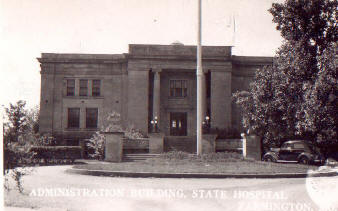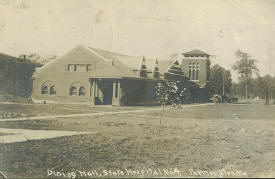 |
FARMINGTON |
 |
FARMINGTON |
A new law to safeguard patients rights
became effective Jan. 1. Not long ago, according to Dennis Mobrice, hospital
public information spokesman, the huge institution dropped its division by
departments and began referring to branches of service as units. Personnel
are encouraged to consider themselves as parts of a system of treatment units,
working closely together. For example, specialists on alcohol and drug abuse
coordinate plans with professionals mainly concerned with continuing care.
Mobrice said the pattern fosters better
administration and accountability plus more flexibility in dealing with
patients. General methods of therapy are said to have been replaced by plans
tailored to the individual resident or outpatient.
Other transitions occurring near the time of
the hospital s 75th
anniversary last year included the appointment of a new superintendent, Dr. Fred
McDaniel, and the retirement of a man who had become an institution in himself,
Dr. Emmett Hoctor. He ended approximately 53 years of continuous service to
the hospital, 38 of those as superintendent.
|
A bill to rename the facility the Emmett F. Hoctor
Medical Complex was pending in the Missouri Legislature early this year.
Hoctor might be one of the few people who
knows of unique features involved in the hospital s early days.
Housing patients in attractive cottages
surrounded by spacious lawns bordering wide streets was part of the hospital
from its birth in 1903. That was a novelty for those times. Mental
patients had almost always been housed in forbidding dormitories. The
architects of the
The picturesque atmosphere has been preserved,
making the sprawling grounds today seem like a college campus.
 |
Another step that made the hospital something
of a pioneer was the addition of a beauty parlor fairly early in its history.
Leaders thought patients deserved the opportunity to keep their hair,
fingernails and the like in sightly condition.
|
Patients in the earlier days were less
anonymous to the general public than they are today. One resident of the
hospital became known in the community as the Major. He was a Boer War
veteran of the British Army, who had been decorated by Queen
Gov. A.M. Dockery was in office then. Dr.
L.T. Hall was the hospital s first superintendent.
More land was added as needed. Today the
complex covers 745 well-tended acres, part of which has been converted to other
uses, including a detention center for juveniles. The mental-care service
area extends over 28 counties with a population of 490,000.
The hospital is
Next year s budget is foreseen at the level
of $13 million. The need for services for the emotionally troubled seems to
grow endlessly. The hospital expanded rapidly upon opening. Ten years
later 631 persons were housed there. In 1935, the annual consumption of beef
amounted to 142,000 pounds, and the year s meals included 18,490 dozen eggs.
 |
|
Today, the institution treats about 5,000
persons a year as residents, outpatients or persons in the care of their
families. Funding is provided from federal, state and local sources and
changes to patients who can afford to pay. Fees are based on a sliding scale
correlated to a patient s income. However, no deserving person is denied
treatment because of lack of income.
A recent addition is a surgical-medical
building of 64 beds, containing an intensive care section and a second ward.
The usual occupancy is between 40 and 45 persons, who are bothered by physical
ailments on top of emotional disorders.
Of the patient population, only about 525 are
residents of the facility. Others are accommodated in nursing homes or their
own homes. Experts think disturbed individuals often fare better away from a
hospital environment. Traveling clinics leave the grounds three times a
month.
Many outpatients are part of the alcohol and
drug abuse treatment center. An estimated 40 percent of all yearly
admissions are into that section, which last year averaged about 35 patients at
a time. Despite intensive professional efforts, an estimated 70 percent of
those admitted for alcoholism return to their problem. Some of those,
however, are thought to cut down on their drinking.
Farmington has many missions in treatment |
A patient enters the
One of the 17 is Carlos Harwood, 28, hospital
mental health coordinator. He is considered the guardian of patients
rights and considers himself as much a representative of the courts and the
general public as the institution. His job was created because of the new
law.
The Probate Court hearing for a 14-day
commitment must be held within a 96-hour (not including weekends or holidays)
period. Subsequent court hearings are mandated during 14-day, 90-day and
one-year commitment periods. After that, patients are guaranteed an annual
review of their hospitalization.
The crisis intervention team is generally made
up of a psychiatrist, a psychiatric nurse, a psychiatric social worker and a
consulting psychologist. The group reviews a new patient s history and
recommends a future course of action. Until early last year, staff and time
limitations confined this service to patients from only 10 counties. Now
persons from all 28 counties served by the hospital are evaluated by the team.
Anyone in the service area with an urgent
problem can now telephone a qualified counselor at the hospital at certain hours
on a toll-free line.
In addition to fulfilling its own function,
the
Thanks goes out to Jeanne "Hunt" Nassaney for typing above article for us.
ADDITIONAL INFORMATION REGARDING DR. HOCTOR |
A book was written about Dr. Hoctor entitled "Let Me Not Be Mad Sweet Heaven", which was published in 1977 by John Stewart, a former minister who called Dr. Hoctor "one of the greatest humanitarians I had the privilege to meet in my lifetime."
Dr. Hoctor was a member of the St. Joseph Catholic Church and served in World War I. He died on May 3, 1986, and was buried in Calvary Cemetery in Omaha, Nebraska.
{Source: Farmington Missouri, the First 200 Years, Copyright 2000.}
The information on this site is provided free for the purpose of researching your genealogy. This material may be freely used by non-commercial entities, for your own research. The information contained in this site may not be copied to any other site without written "snail-mail" permission. If you wish to have a copy of a donor's material, you must have their permission. All information found on these pages is under copyright of Oklahoma Cemeteries. This is to protect any and all information donated. The original submitter or source of the information will retain their copyright. Unless otherwise stated, any donated material is given to MOGenWeb to make it available online.